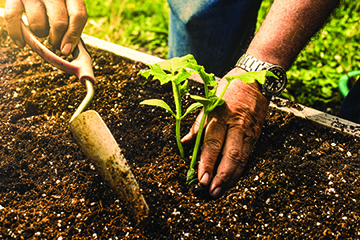Amber Starling
news@greenepublishing.com
June is a poor time for planting, but a great time for completing chores around the farm! Where winter can be a great time for spring soil preparation, summer is an excellent time for fall soil preparation.
Before you start picking out your seeds, you must prepare your soil. The Florida Extension Service recommends that you site, plan and prepare before you begin.
This is all well and good if you have nothing planted. But what if your garden is already full? You should be leaving a portion of your garden fallow each season. This allows the soil to rest between crops. Some gardeners will plant a cover crop like clover and then plow it under a little before planting again. Clover puts nitrogen and minerals back into the soil when used in this way.
If you have not yet created a fallow plot, make one this month. This will be a whole new plot, a clean slate for you to lovingly manage, so let's get started with the site, plan, prepare method and then you are ready to plant!
The following few are good to plant in June:
Eggplant is an incredible producer, yielding 200 lb of produce per 100 feet of space. (Peppers, for a comparison, only yield 40 lb per 100 feet.) It takes 90-110 days until harvest, though the time can be shortened to 75 days if using mature transplants. Eggplant can be fried, stewed, boiled, eaten raw and used in various other preparations. It is rich in fiber and is often used in vegetarian dishes.
Lima Beans are nutritious and tasty; southern cooks do not often add more than salt, pepper and a little bacon fat to season these vegetables, which have a natural flavor that is fresh, sweet and umami. Lima beans require plenty of warm soil, so they can be planted through the summer. They require 60-90 days of heat (soil temperatures above 65 degrees) to mature, so do not plant them too close to the cooler fall months. Sow your seeds three to four inches apart and one to two inches deep.
Okra is another staple of southern cuisine. Some love it, some hate it, but everyone can agree that the best okra is fresh. Okra takes 50-75 days to harvest, so plant soon for an early summer harvest. Plant the seeds one to two inches deep and six to 12 inches apart. Okra is good fried and stewed. When stewing, add tomatoes and onions; the tomatoes provide an acid to cut the slimy texture of the okra and the onions provide flavor.
Southern Peas are especially suited to— you guessed it— the South. They enjoy hot, well-drained soil. They are known as cowpeas, crowder peas and black-eyed peas. Do not apply nitrogen to these peas, as they will develop lush foliage and poorer yield. In fact, co-planting with corn is a fine practice; corn takes a lot of nitrogen out of the soil during its growth process, and offers a support for vining varieties of these peas to grow up. Plant two to three inches apart and one to two inches deep. When cooking, add a little pork fat.
Winter squash seem like a strange thing to even be thinking of while the summer sun bathes your garden. However, winter squashes require a long growth period of approximately 100 days, which means that if you planted them today, you wouldn't see a crop until mid-September. These vegetables are prized for being low in calories and fat, high in vitamins and minerals, and for having a long pantry life.
Bees are required for pollination, and irrigation is important for seedlings, but once the vines cover the ground, the plants are quite hardy and require little care. Make a little dirt hill and plant about four seeds one to two inches deep. Space hills three to four feet apart.

